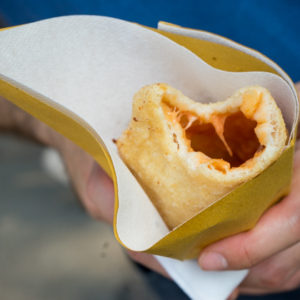The Italian Larder
Search by alphabet:
A B C D E F G H I J K L M N O P R S T U V W Y Z
Watermelon – See Melon
Weever – See Fish: Weever
White mushroom – See Mushroom: Button
White onion– See Onion
Whitebait– See Fish: Whitebait
Whitefish, European – See Fish: Whitefish, European
Whiting, blue – See Fish: Whiting, blue
Wild Boar (Cinghiale) (Sus scrofa)
Substitute: wild boar under one year old can be substituted with pork; fillet and upper rib of cinghialotto can be substituted with roe deer or chamois
Wild boar is a type of wild pig that roams wild still in northern and central Italy, and Sardegna. There is also a crossbred between pig and wild boar (meticcio). Wild boar can be wild or semi-wild (live within fenced-in areas). It is particularly prized in Toscana and Lazio.
Buy: The ideal age to buy wild boar is under six months of age as it will be juicier and more succulent. It is best to purchase wild boar displayed with the skin attached so it is easier to ascertain its age. It should be hung for 3 days for cinghialotto and 8 days for adulto after killing. Wild boar is sold fresh or frozen. If purchasing frozen wild boar, then it should only be braised or stewed. See Pork for cuts. The tongue is also eaten.
Categories:
Porcastro milk-fed baby
Cinghialotto / Cinghialetto is between three to six months of age and has clear horizontal stripes in the fur. The meat is tender and delicate. Butchers often leave a layer of fat on after skinning the wild boar. It can be cooked using any method, even roasted. It does not need to be marinated. The upper spare rib, blade, chump and leg can be roasted, grilled or pan-fried. The shoulder and other cuts should be braised or stewed with light seasonings.
Giovane is between six months to one year old and the fur is tawny coloured. The meat is tender and has a slightly strong flavour. Butchers often leave a layer of fat on after skinning the wild boar. It should be lightly marinated. The fillet, upper spare rib and blade can be roasted. The other cuts can be braised or stewed.
Maturo is between one and two years old and has darker fur. The meat is excellent and has a gamy but pleasant flavour. It needs to be marinated for a long period of time. The blade (should be sliced), upper rib and fillet can be roasted. The rest of the cuts should be braised or stewed.
Adulto is older than two years of age and has almost black fur. It is tough with a strong gamy flavour. If it is less than six years old then it should be marinated for up to 48 hours and then braised, stewed, or stewed in wine (in salmì). Wild boar older than six years of age are unpleasant to eat.
Store: See Pork
Prepare: See Pork and specific categories above
Eat: Wild boar is pan-fried (costolette di cinghialetto), roasted (cosciotto di cinghialetto), braised (cinghiale al civé), spit-roasted (cinghiale all’Aspromonte), stewed (cinghiale alla cacciatora, cinghiale alla maremmana, cinchiale alle erbe, cinghiale in umido, spezzatino di cinghiale) and made into meat sauce to dress pasta (pappardelle al ragù di cinghiale). It is also made into sausages (salsiccia di cinghiale), coppa, prosciutto (prosciutto di cinghiale) or salami (salame di cinghiale). Older wild boar needs to be flavoured with strong aromatics and stewed (cinghiale in agrodolce, scottiglie di cinghiale). It pairs well with fennel, juniper, myrtle, chestnut, blueberries, currants and mushrooms.
Wine must syrup – See Grape
Wrasse, cleaver – See Fish: Wrasse, cleaver








Leave a Reply